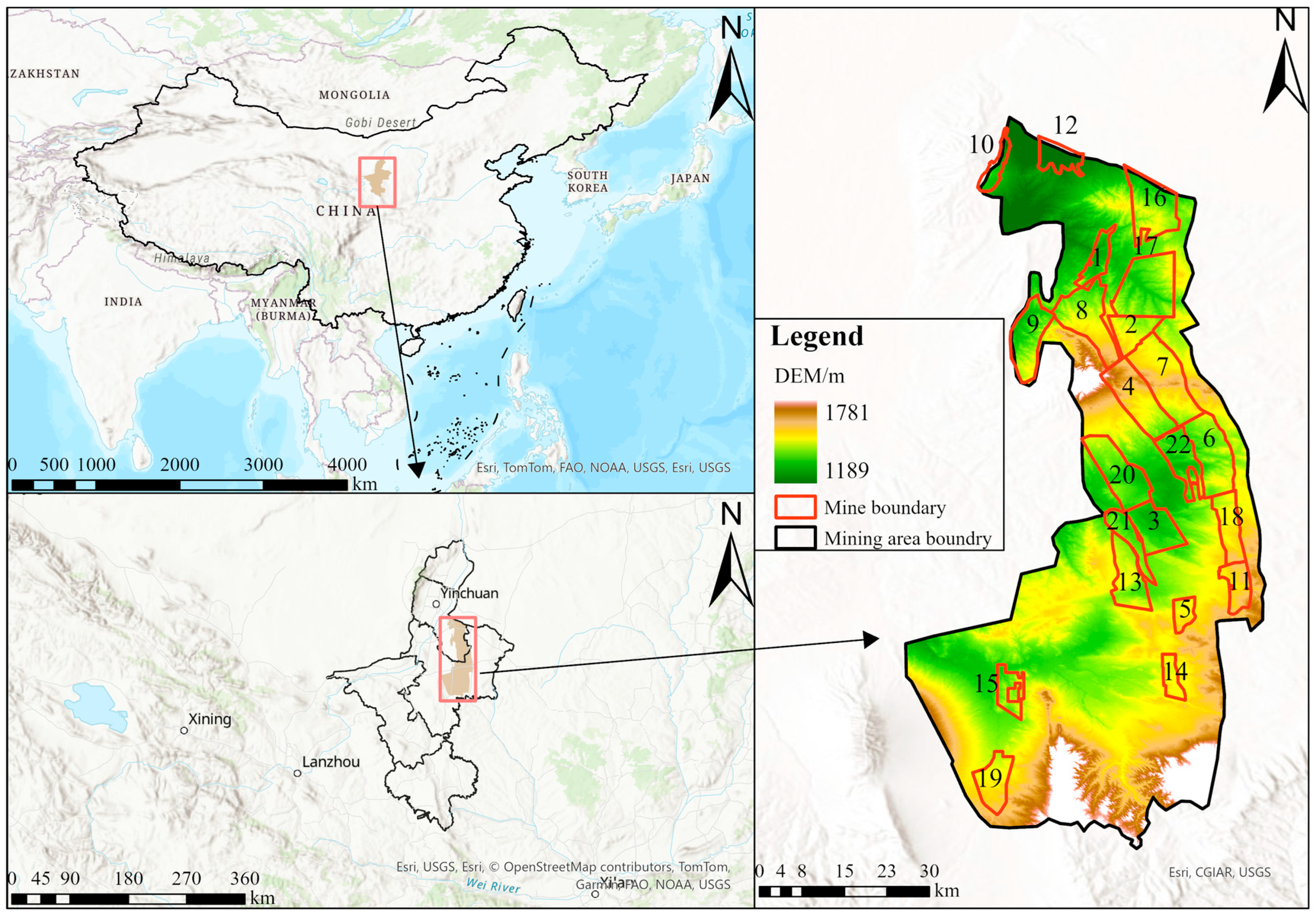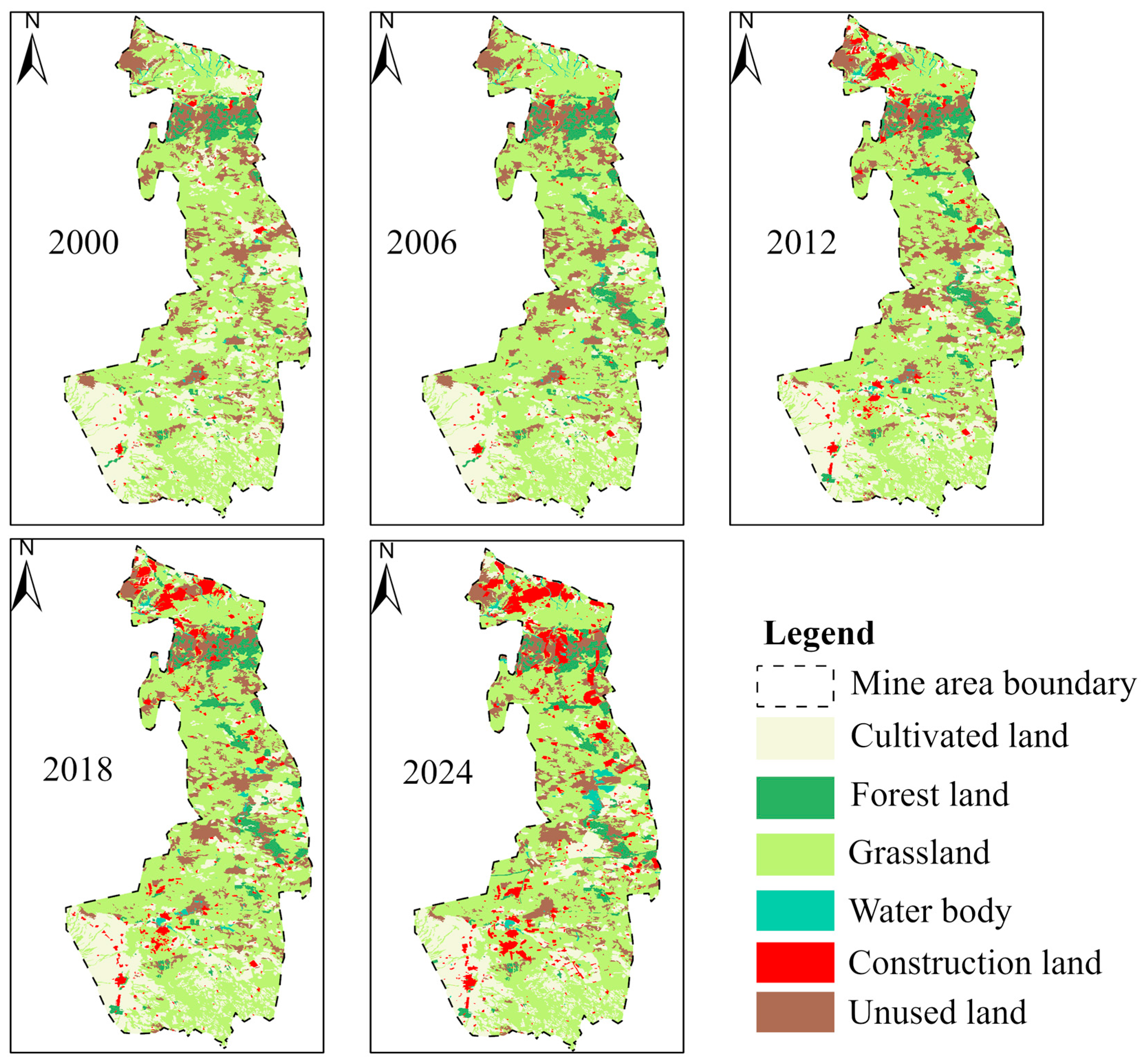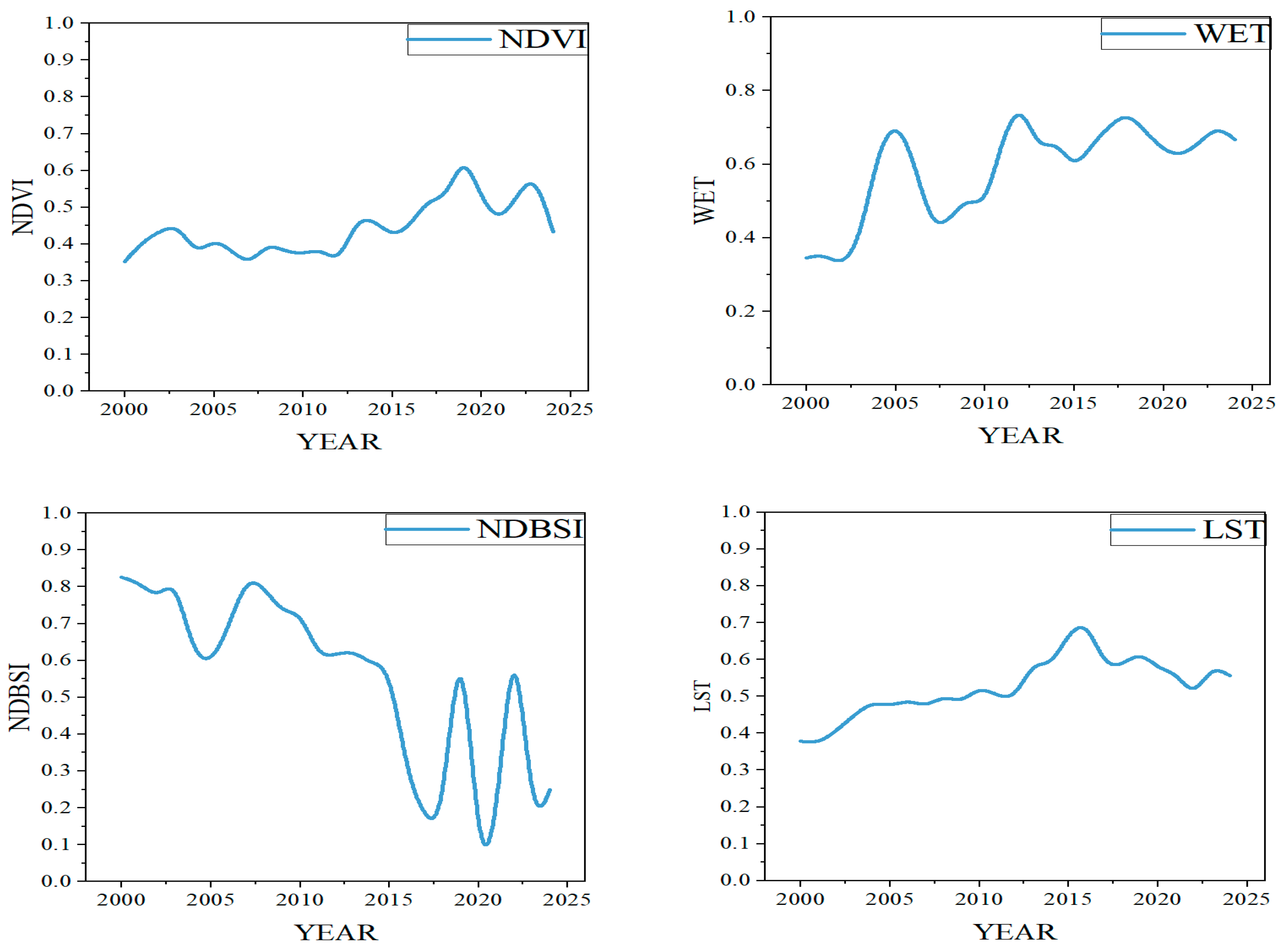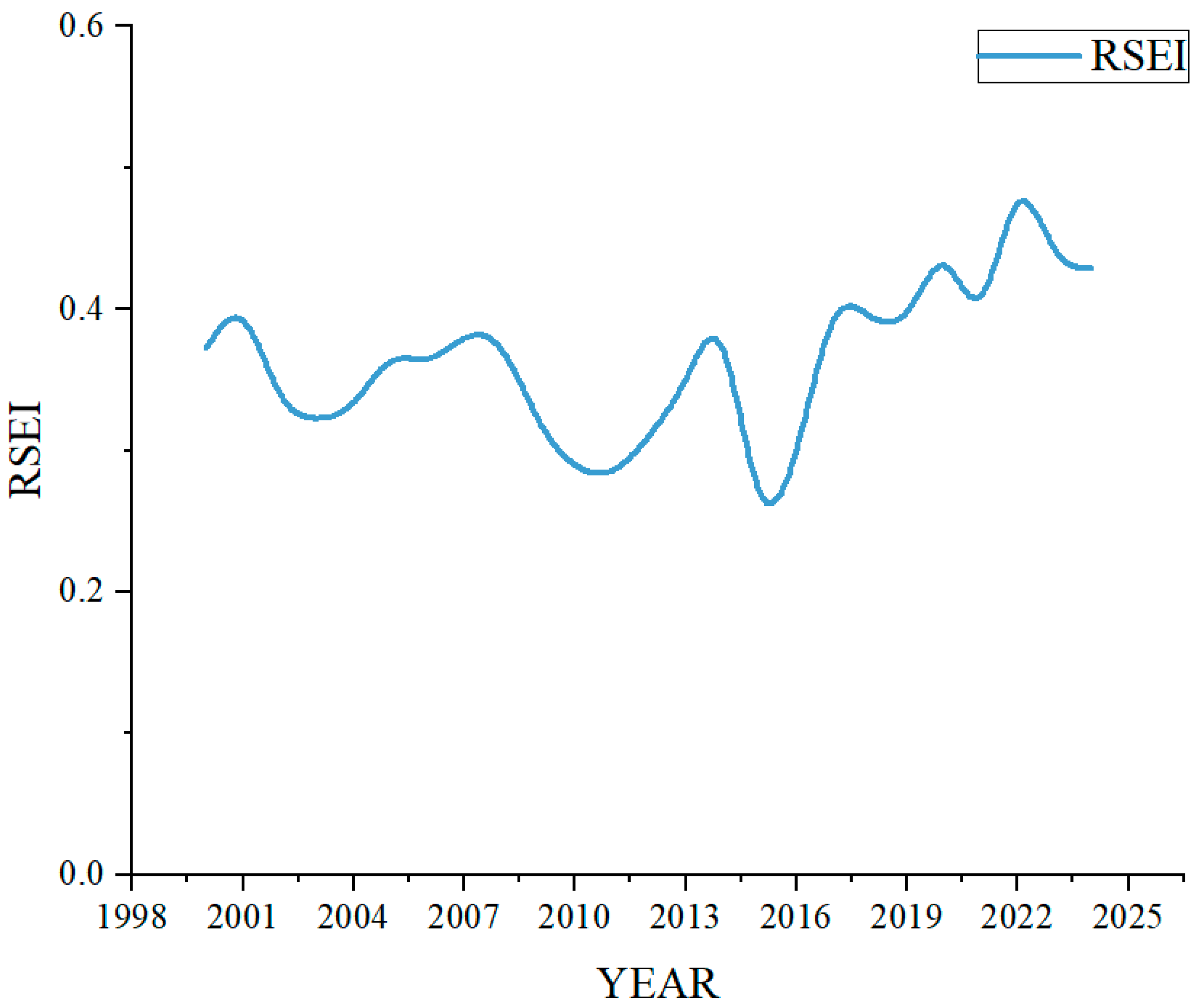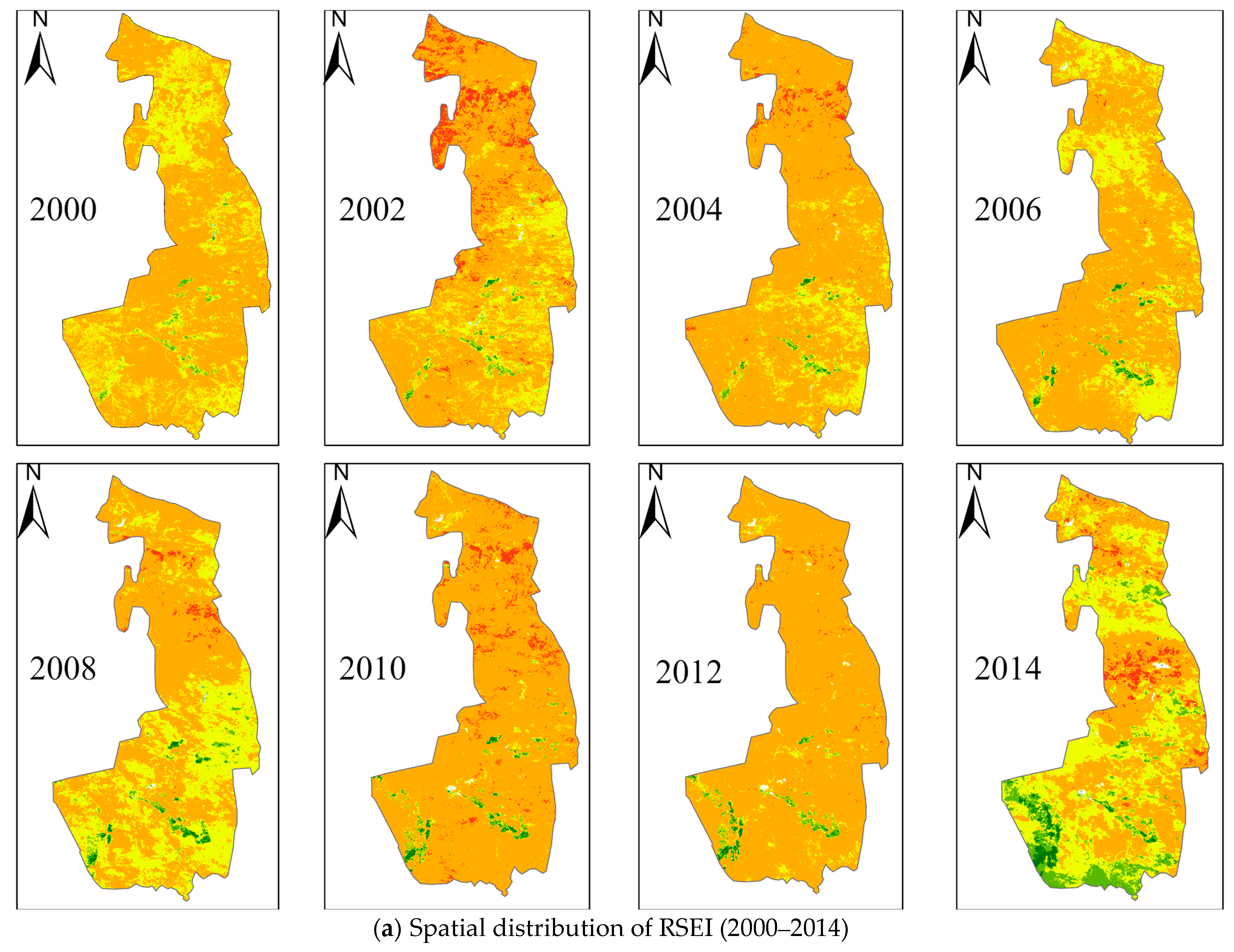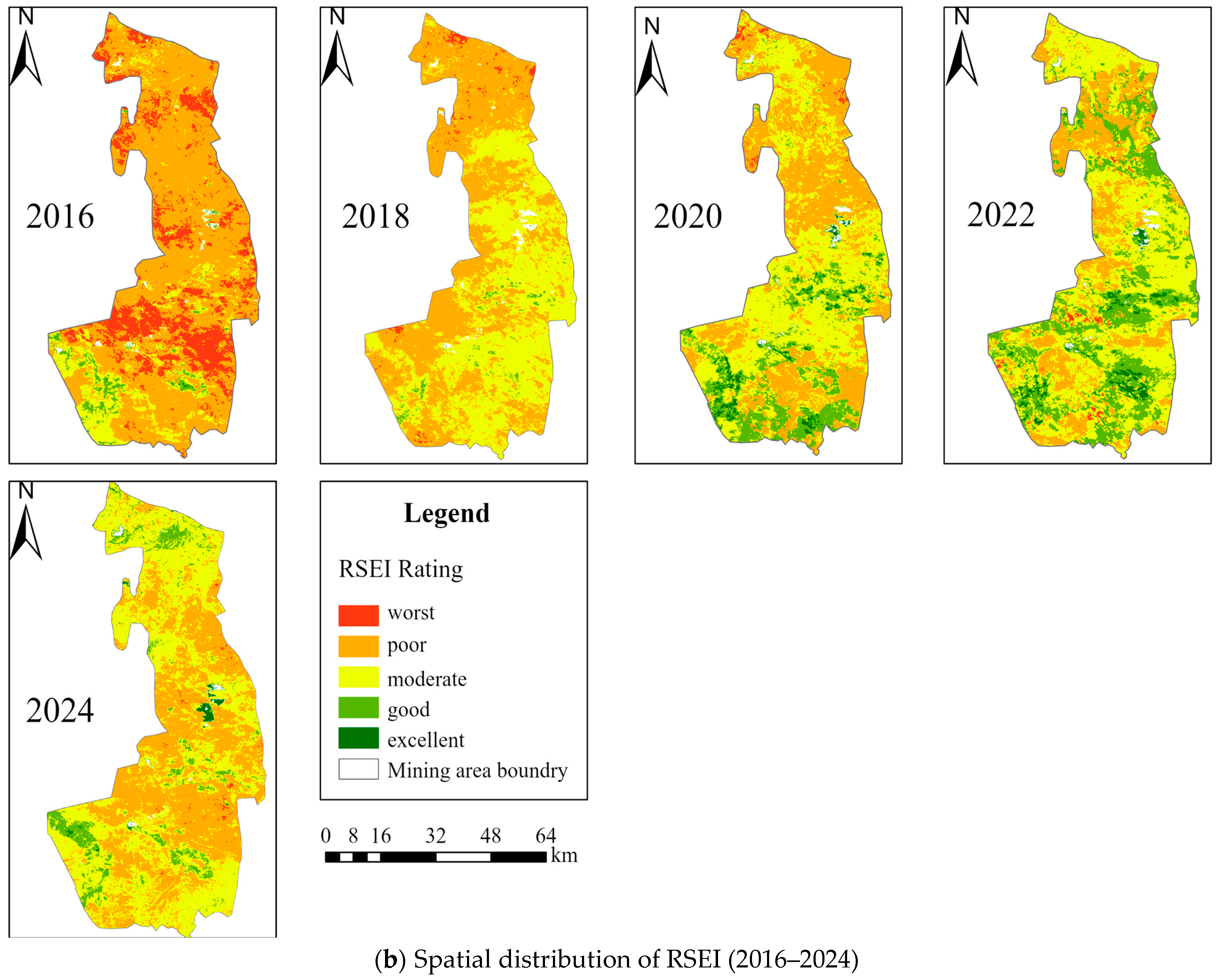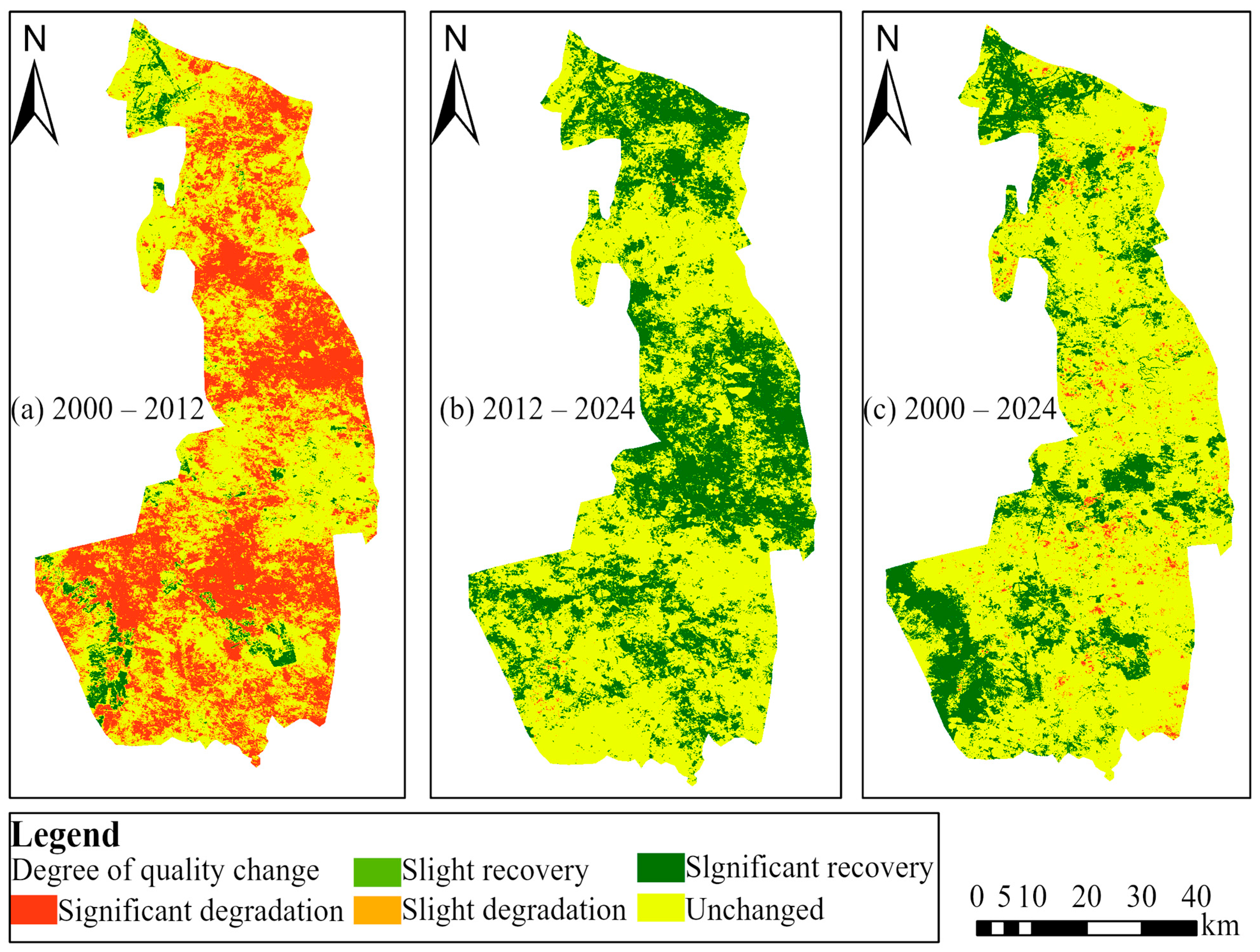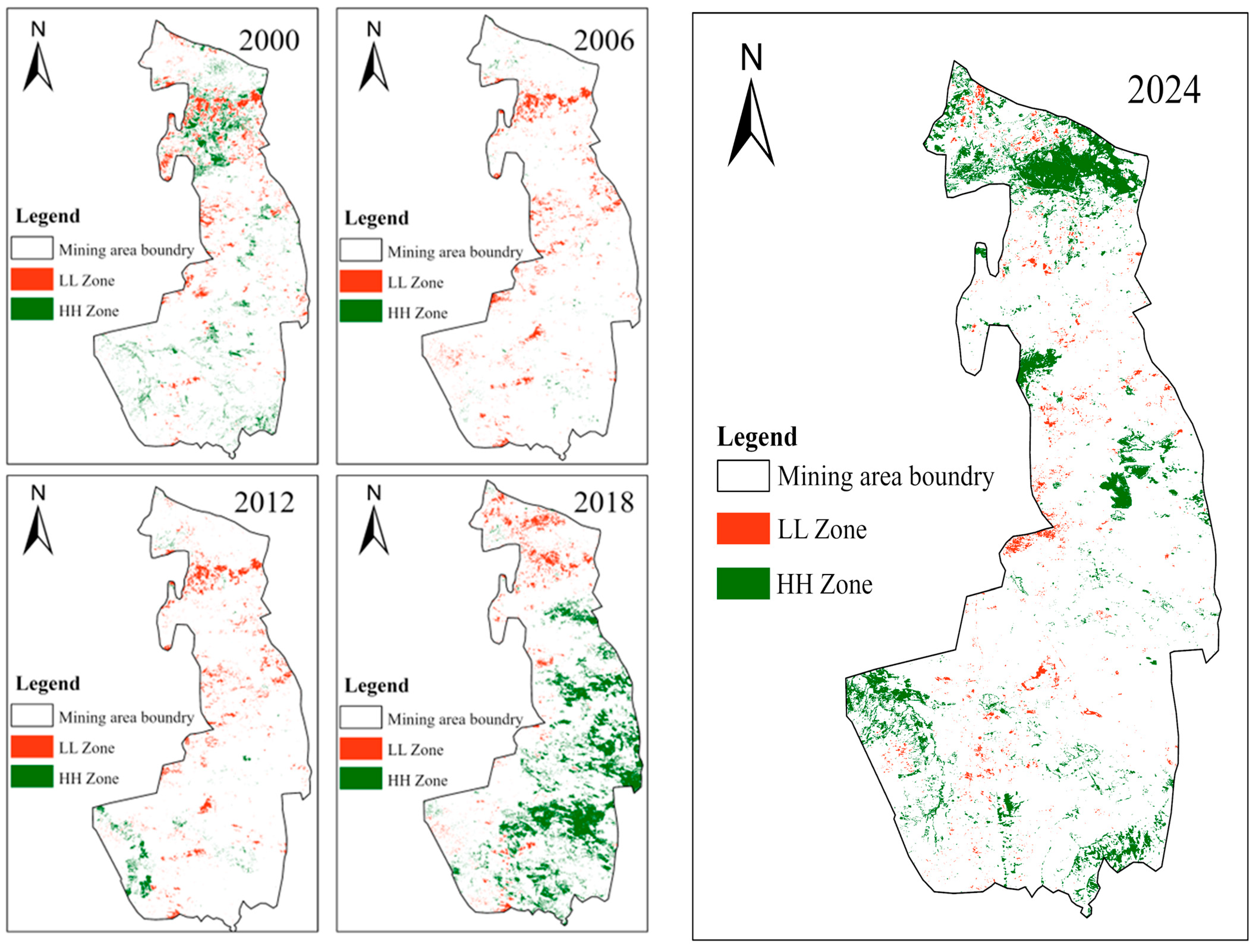Figure 1.
Location Map of the Ningdong mining area and distribution of coal mines. (1) Lingxin, (2) Shicao Village, (3) Yin Xing No. 2, (4) Maiduo Mountain, (5) Song Xinzhuang, (6) Shuangma No. 1, (7) Hongliu, (8) Yangchangwan, (9) Zaoquan, (10) Sirenjiazhuang, (11) Jinjiaqu, (12) Maliantai, (13) Xinqiao, (14) Huian, (15) Yong’an, (16) Qingshuiying, (17) Meihuajing, (18) Jinfeng, (19) Wei’er, (20) Yin Xing No. 1, (21) Yue’erwan, and (22) Shuangma No. 2.
Figure 1.
Location Map of the Ningdong mining area and distribution of coal mines. (1) Lingxin, (2) Shicao Village, (3) Yin Xing No. 2, (4) Maiduo Mountain, (5) Song Xinzhuang, (6) Shuangma No. 1, (7) Hongliu, (8) Yangchangwan, (9) Zaoquan, (10) Sirenjiazhuang, (11) Jinjiaqu, (12) Maliantai, (13) Xinqiao, (14) Huian, (15) Yong’an, (16) Qingshuiying, (17) Meihuajing, (18) Jinfeng, (19) Wei’er, (20) Yin Xing No. 1, (21) Yue’erwan, and (22) Shuangma No. 2.
Figure 2.
Field photographs of the landscape at the six studied coal mining areas.
Figure 2.
Field photographs of the landscape at the six studied coal mining areas.
Figure 3.
Study methods overview.
Figure 3.
Study methods overview.
Figure 4.
Temporal land use maps of the study area (2000, 2006, 2012, 2018, and 2024).
Figure 4.
Temporal land use maps of the study area (2000, 2006, 2012, 2018, and 2024).
Figure 5.
Variation curves for NDVI, WET, NDBSI, and LST from 2000 to 2024.
Figure 5.
Variation curves for NDVI, WET, NDBSI, and LST from 2000 to 2024.
Figure 6.
Three-dimensional spatial patterns of remote sensing indices and RSEI confidence region analysis.
Figure 6.
Three-dimensional spatial patterns of remote sensing indices and RSEI confidence region analysis.
Figure 7.
RSEI variation curve.
Figure 7.
RSEI variation curve.
Figure 8.
Non-monotonic evolution of RSEI: U-shaped transition and segmented dynamics driven by policy intervention.
Figure 8.
Non-monotonic evolution of RSEI: U-shaped transition and segmented dynamics driven by policy intervention.
Figure 9.
RSEI classification by year.
Figure 9.
RSEI classification by year.
Figure 10.
Changes in RSEI by year.
Figure 10.
Changes in RSEI by year.
Figure 11.
Clustered bar and percentage stacked composite chart of ecological quality dynamics.
Figure 11.
Clustered bar and percentage stacked composite chart of ecological quality dynamics.
Figure 12.
EG index variation curve.
Figure 12.
EG index variation curve.
Figure 13.
Temporal evolution of HH/LL clusters of environmental quality based on EG and RSEI (2000–2024).
Figure 13.
Temporal evolution of HH/LL clusters of environmental quality based on EG and RSEI (2000–2024).
Figure 14.
Results of the factor interaction detection: heatmaps of interaction q-values for variable pairs (2019–2024).
Figure 14.
Results of the factor interaction detection: heatmaps of interaction q-values for variable pairs (2019–2024).
Figure 15.
Schematic diagram of the weighted overlay integration model for RSEI and EG.
Figure 15.
Schematic diagram of the weighted overlay integration model for RSEI and EG.
Table 1.
Remote sensing imagery data.
Table 1.
Remote sensing imagery data.
| Sensor | Resolution | Time | Period | GEE Datasets |
|---|
| Landsat 5 TM | 30 m | 2000–2011 | June to September | LANDSAT/LT05/C02/T1_L2 |
| Landsat 7 ETM+ | 30 m | 2012 | June to September | LANDSAT/LE07/C02/T1_L2 |
| Landsat 8 OLI | 30 m | 2013–2020 | June to September | LANDSAT/LC08/C02/T1_L2 |
Table 2.
Values of and in the heat indicator.
Table 2.
Values of and in the heat indicator.
| Waveband | | |
|---|
| Landsat 5 B6 | 607.76 | 1260.56 |
| Landsat 7 B6 | 666.09 | 1282.71 |
| Landsat 8 B10 | 774.89 | 1321.08 |
Table 3.
Land use types and their ecological grade index in the study area.
Table 3.
Land use types and their ecological grade index in the study area.
| Land Use and Land Cover Type | Ecological Grade | Ecological Land |
|---|
| Water body | 1 | YES |
| Wetland | 1 | YES |
| Forest | 2 | YES |
| Shrubland | 3 | YES |
| Grassland | 4 | YES |
| Cultivated land | 5 | NO |
| Construction land | 6 | NO |
| Barren land | 7 | NO |
Table 4.
Two-by-two factorial interaction results.
Table 4.
Two-by-two factorial interaction results.
| Comparison of p(x1), p(x2) with p(x1 ∩ x2) | Factor Interaction Results |
|---|
| p(x1 ∩ x2) > max(p(x1), p(x2)) | Bilinear enhancement |
| p(x1 ∩ x2) > p(x1) + p(x2) | Nonlinear enhancement |
| p(x1 ∩ x2) = p(x1) + p(x2) | Mutually independent |
| min(p(x1), p(x2)) < p(x1 ∩ x2) < max(p(x1), p(x2)) | Linear deceleration |
| p(x1 ∩ x2) < min(p(x1), p(x2)) | Nonlinear attenuation |
Table 5.
Indicator values.
Table 5.
Indicator values.
| | RSEI | NDVI | WET | NDBSI | LST | Percentage (%) |
|---|
| 2000 | 0.372 | 0.352 | 0.345 | 0.826 | 0.377 | 62.56 |
| 2001 | 0.412 | 0.406 | 0.355 | 0.809 | 0.372 | 60.96 |
| 2002 | 0.328 | 0.436 | 0.323 | 0.768 | 0.408 | 62.70 |
| 2003 | 0.319 | 0.452 | 0.393 | 0.826 | 0.450 | 64.27 |
| 2004 | 0.328 | 0.370 | 0.638 | 0.614 | 0.485 | 62.37 |
| 2005 | 0.372 | 0.415 | 0.722 | 0.589 | 0.473 | 63.58 |
| 2006 | 0.358 | 0.379 | 0.614 | 0.694 | 0.490 | 62.59 |
| 2007 | 0.383 | 0.343 | 0.426 | 0.829 | 0.471 | 58.59 |
| 2008 | 0.382 | 0.402 | 0.445 | 0.798 | 0.502 | 66.82 |
| 2009 | 0.316 | 0.380 | 0.510 | 0.728 | 0.481 | 66.25 |
| 2010 | 0.286 | 0.373 | 0.479 | 0.734 | 0.527 | 68.97 |
| 2011 | 0.279 | 0.387 | 0.677 | 0.608 | 0.502 | 70.45 |
| 2012 | 0.308 | 0.347 | 0.770 | 0.616 | 0.493 | 72.06 |
| 2013 | 0.345 | 0.470 | 0.638 | 0.626 | 0.595 | 70.22 |
| 2014 | 0.413 | 0.465 | 0.665 | 0.590 | 0.580 | 84.79 |
| 2015 | 0.231 | 0.418 | 0.585 | 0.585 | 0.672 | 79.65 |
| 2016 | 0.288 | 0.449 | 0.653 | 0.286 | 0.705 | 80.67 |
| 2017 | 0.417 | 0.522 | 0.704 | 0.170 | 0.582 | 85.54 |
| 2018 | 0.391 | 0.522 | 0.742 | 0.148 | 0.583 | 71.82 |
| 2019 | 0.385 | 0.650 | 0.688 | 0.782 | 0.621 | 84.37 |
| 2020 | 0.456 | 0.521 | 0.637 | 0.118 | 0.574 | 77.19 |
| 2021 | 0.372 | 0.459 | 0.622 | 0.129 | 0.565 | 79.92 |
| 2022 | 0.511 | 0.531 | 0.657 | 0.774 | 0.495 | 82.16 |
| 2023 | 0.429 | 0.595 | 0.705 | 0.132 | 0.584 | 80.77 |
| 2024 | 0.428 | 0.433 | 0.666 | 0.249 | 0.556 | 77.83 |
Table 6.
Temporal distribution matrix of RSEI ecological class areas (2000–2012).
Table 6.
Temporal distribution matrix of RSEI ecological class areas (2000–2012).
| Ecological Class | 2000 () | 2002 () | 2004 () | 2006 () | 2008 () | 2010 () | 2012 () |
|---|
| Worst | 1.392 | 250.263 | 62.661 | 767.935 | 42.700 | 153.000 | 20.039 |
| Poor | 2463.928 | 2445.636 | 2867.746 | 2527.589 | 2023.048 | 3004.961 | 3105.284 |
| Moderate | 871.446 | 631.106 | 406.195 | 52.190 | 1197.719 | 125.575 | 159.591 |
| Good | 33.094 | 38.982 | 28.203 | 12.563 | 84.939 | 54.557 | 57.757 |
| Excellent | 0.940 | 4.844 | 5.744 | 10.456 | 22.019 | 22.276 | 18.308 |
Table 7.
Temporal distribution matrix of RSEI ecological class areas (2014–2024).
Table 7.
Temporal distribution matrix of RSEI ecological class areas (2014–2024).
| Ecological Class | 2014 () | 2016 () | 2018 () | 2020 () | 2022 () | 2024 () |
|---|
| Worst | 109.384 | 631.987 | 41.088 | 21.374 | 28.439 | 13.642 |
| Poor | 1574.917 | 2231.431 | 1700.492 | 1315.977 | 827.962 | 1470.820 |
| Moderate | 1309.992 | 416.613 | 1582.091 | 1479.357 | 1590.826 | 1626.880 |
| Good | 319.590 | 79.882 | 36.545 | 489.984 | 844.275 | 229.284 |
| Excellent | 46.776 | 1.078 | 0.003 | 54.162 | 68.587 | 19.995 |
Table 8.
EG index values (2000–2012).
Table 8.
EG index values (2000–2012).
| Year | 2000 | 2001 | 2002 | 2003 | 2004 | 2005 | 2006 | 2007 | 2008 | 2009 | 2010 | 2011 | 2012 |
|---|
| EG index | 0.560 | 0.550 | 0.554 | 0.560 | 0.552 | 0.551 | 0.543 | 0.540 | 0.540 | 0.542 | 0.541 | 0.541 | 0.541 |
Table 9.
EG index values (2013–2024).
Table 9.
EG index values (2013–2024).
| Year | 2013 | 2014 | 2015 | 2016 | 2017 | 2018 | 2019 | 2020 | 2021 | 2022 | 2023 | 2024 |
|---|
| EG index | 0.541 | 0.550 | 0.547 | 0.548 | 0.548 | 0.548 | 0.548 | 0.547 | 0.547 | 0.545 | 0.549 | 0.550 |
Table 10.
RSEI values for each coal mine (2019–2024).
Table 10.
RSEI values for each coal mine (2019–2024).
| Coal Mine Name | 2019 | 2020 | 2021 | 2022 | 2023 | 2024 |
|---|
| Lingxin | 0.277 | 0.249 | 0.410 | 0.259 | 0.411 | 0.275 |
| Shicao Village | 0.444 | 0.308 | 0.410 | 0.293 | 0.486 | 0.314 |
| Yin Xing No. 2 | 0.439 | 0.353 | 0.509 | 0.379 | 0.544 | 0.571 |
| Maiduo Mountain | 0.395 | 0.337 | 0.319 | 0.270 | 0.461 | 0.381 |
| Song Xinzhuang | 0.414 | 0.418 | 0.530 | 0.352 | 0.580 | 0.413 |
| Shuangma No. 1 | 0.417 | 0.339 | 0.393 | 0.292 | 0.544 | 0.465 |
| Hongliu | 0.409 | 0.333 | 0.359 | 0.274 | 0.552 | 0.384 |
| Yangchangwan | 0.346 | 0.294 | 0.413 | 0.302 | 0.403 | 0.288 |
| Zaoquan | 0.273 | 0.28 | 0.310 | 0.299 | 0.377 | 0.259 |
| Sirenjiazhuang | 0.321 | 0.21 | 0.332 | 0.294 | 0.375 | 0.245 |
| Jinjiaqu | 0.453 | 0.483 | 0.455 | 0.393 | 0.558 | 0.470 |
| Maliantai | 0.207 | 0.299 | 0.378 | 0.331 | 0.468 | 0.326 |
| Xinqiao | 0.431 | 0.436 | 0.556 | 0.485 | 0.622 | 0.503 |
| Huian | 0.511 | 0.383 | 0.491 | 0.359 | 0.530 | 0.468 |
| Yong’an | 0.350 | 0.351 | 0.452 | 0.399 | 0.389 | 0.359 |
| Qingshuiying | 0.276 | 0.288 | 0.318 | 0.290 | 0.456 | 0.378 |
| Meihuajing | 0.352 | 0.308 | 0.366 | 0.291 | 0.514 | 0.324 |
| Jinfeng | 0.438 | 0.413 | 0.506 | 0.362 | 0.517 | 0.507 |
| Wei’er | 0.415 | 0.562 | 0.639 | 0.563 | 0.571 | 0.549 |
| Yin Xing No. 1 | 0.413 | 0.333 | 0.382 | 0.318 | 0.414 | 0.412 |
| Yue’erwan | 0.414 | 0.357 | 0.509 | 0.382 | 0.480 | 0.545 |
| Shuangma No. 2 | 0.431 | 0.403 | 0.419 | 0.334 | 0.485 | 0.520 |
Table 11.
Static factors for each coal mine.
Table 11.
Static factors for each coal mine.
| Coal Mine Name | Annual Coal Production
(10 kt) | Elevation
(m) | Slope
(°) | Aspect
(°) |
|---|
| Lingxin | 390 | 1324.379 | 3.624 | 182.211 |
| Shicao Village | 600 | 1401.325 | 3.213 | 157.147 |
| Yin Xing No. 2 | 220 | 1335.301 | 2.308 | 167.537 |
| Maiduo Mountain | 800 | 1437.247 | 3.210 | 155.797 |
| Song Xinzhuang | 120 | 1418.064 | 2.500 | 186.257 |
| Shuangma No. 1 | 400 | 1374.000 | 3.131 | 184.354 |
| Hongliu | 800 | 1426.646 | 3.469 | 171.474 |
| Yangchangwan | 1200 | 1400.696 | 2.868 | 173.383 |
| Zaoquan | 500 | 1357.708 | 3.285 | 191.215 |
| Sirenjiazhuang | 240 | 1307.117 | 4.538 | 164.704 |
| Jinjiaqu | 400 | 1450.258 | 3.044 | 195.070 |
| Maliantai | 360 | 1250.939 | 2.923 | 181.623 |
| Xinqiao | 240 | 1385.474 | 2.285 | 155.618 |
| Huian | 150 | 1410.438 | 2.384 | 175.236 |
| Yong’an | 120 | 1369.074 | 2.827 | 190.394 |
| Qingshuiying | 1000 | 1366.480 | 3.127 | 167.162 |
| Meihuajing | 1200 | 1363.546 | 3.066 | 184.798 |
| Jinfeng | 400 | 1422.189 | 3.014 | 184.437 |
| Wei’er | 150 | 1423.622 | 1.946 | 170.967 |
| Yin Xing No. 1 | 400 | 1354.250 | 2.425 | 167.794 |
| Yue’erwan | 180 | 1357.772 | 2.260 | 162.098 |
| Shuangma No. 2 | 400 | 1342.211 | 2.816 | 179.299 |
Table 12.
Dynamic factors of each coal mine (temperature).
Table 12.
Dynamic factors of each coal mine (temperature).
| Coal Mine Name | 2019 (°C) | 2020 (°C) | 2021 (°C) | 2022 (°C) | 2023 (°C) | 2024 (°C) |
|---|
| Lingxin | 21.227 | 21.095 | 20.864 | 21.422 | 21.768 | 21.927 |
| Shicao Village | 21.227 | 21.095 | 20.864 | 21.422 | 21.768 | 21.927 |
| Yin Xing No. 2 | 21.474 | 21.360 | 21.135 | 21.635 | 22.009 | 22.166 |
| Maiduo Mountain | 20.954 | 20.831 | 20.605 | 21.135 | 21.479 | 21.624 |
| Song Xinzhuang | 20.899 | 20.754 | 20.519 | 21.069 | 21.407 | 21.539 |
| Shuangma No. 1 | 20.899 | 20.754 | 20.519 | 21.069 | 21.407 | 21.539 |
| Hongliu | 20.954 | 20.831 | 20.605 | 21.135 | 21.479 | 21.624 |
| Yangchangwan | 21.227 | 21.095 | 20.864 | 21.422 | 21.768 | 21.927 |
| Zaoquan | 20.954 | 20.831 | 20.605 | 21.135 | 21.479 | 21.624 |
| Sirenjiazhuang | 21.784 | 21.659 | 21.438 | 21.986 | 22.287 | 22.476 |
| Jinjiaqu | 20.899 | 20.754 | 20.519 | 21.069 | 21.407 | 21.539 |
| Maliantai | 21.784 | 21.659 | 21.438 | 21.986 | 22.287 | 22.476 |
| Xinqiao | 20.606 | 20.437 | 20.201 | 20.767 | 21.056 | 21.187 |
| Huian | 20.606 | 20.437 | 20.201 | 20.767 | 21.056 | 21.187 |
| Yong’an | 21.146 | 20.988 | 20.776 | 21.298 | 21.617 | 21.767 |
| Qingshuiying | 21.227 | 21.095 | 20.864 | 21.422 | 21.768 | 21.927 |
| Meihuajing | 21.227 | 21.095 | 20.864 | 21.422 | 21.768 | 21.927 |
| Jinfeng | 20.899 | 20.754 | 20.519 | 21.069 | 21.407 | 21.539 |
| Wei’er | 20.309 | 20.129 | 19.915 | 20.467 | 20.736 | 20.880 |
| Yin Xing No. 1 | 21.474 | 21.360 | 21.135 | 21.635 | 22.009 | 22.166 |
| Yue’erwan | 20.899 | 20.754 | 20.519 | 21.069 | 21.407 | 21.539 |
| Shuangma No. 2 | 20.954 | 20.831 | 20.605 | 21.135 | 21.479 | 21.624 |
Table 13.
Dynamic factors of each coal mine (precipitation).
Table 13.
Dynamic factors of each coal mine (precipitation).
| Coal Mine Name | 2019 (mL) | 2020 (mL) | 2021 (mL) | 2022 (mL) | 2023 (mL) | 2024 (mL) |
|---|
| Lingxin | 305.987 | 252.430 | 267.449 | 245.972 | 310.783 | 213.756 |
| Shicao Village | 305.987 | 252.430 | 267.449 | 245.972 | 310.783 | 213.756 |
| Yin Xing No. 2 | 309.805 | 308.617 | 289.496 | 285.235 | 316.772 | 259.292 |
| Maiduo Mountain | 319.656 | 305.967 | 296.076 | 286.712 | 325.953 | 257.475 |
| Song Xinzhuang | 369.703 | 321.723 | 339.543 | 327.273 | 367.106 | 290.660 |
| Shuangma No. 1 | 369.703 | 321.723 | 339.543 | 327.273 | 367.106 | 290.660 |
| Hongliu | 319.656 | 305.967 | 296.076 | 286.712 | 325.953 | 257.475 |
| Yangchangwan | 305.987 | 252.430 | 267.449 | 245.972 | 310.783 | 213.756 |
| Zaoquan | 319.656 | 305.967 | 296.076 | 286.712 | 325.953 | 257.475 |
| Sirenjiazhuang | 290.997 | 215.706 | 237.198 | 213.656 | 294.292 | 180.770 |
| Jinjiaqu | 369.703 | 321.723 | 339.543 | 327.273 | 367.106 | 290.660 |
| Maliantai | 290.997 | 215.706 | 237.198 | 213.656 | 294.292 | 180.770 |
| Xinqiao | 406.405 | 302.819 | 356.137 | 341.721 | 394.160 | 294.430 |
| Huian | 406.405 | 302.819 | 356.137 | 341.721 | 394.160 | 294.430 |
| Yong’an | 362.083 | 291.004 | 316.802 | 305.687 | 354.719 | 267.739 |
| Qingshuiying | 305.987 | 252.430 | 267.449 | 245.972 | 310.783 | 213.756 |
| Meihuajing | 305.987 | 252.430 | 267.449 | 245.972 | 310.783 | 213.756 |
| Jinfeng | 369.703 | 321.723 | 339.543 | 327.273 | 367.106 | 290.660 |
| Wei’er | 396.360 | 277.219 | 331.424 | 316.447 | 381.289 | 268.668 |
| Yin Xing No. 1 | 309.805 | 308.617 | 289.496 | 285.235 | 316.772 | 259.292 |
| Yue’erwan | 369.703 | 321.723 | 339.543 | 327.273 | 367.106 | 290.660 |
| Shuangma No. 2 | 319.656 | 305.967 | 296.076 | 286.712 | 325.953 | 257.475 |
Table 14.
Various influence factor q-values.
Table 14.
Various influence factor q-values.
| Year | X1 | X2 | X3 | X4 | X5 | X6 |
|---|
| 2019 | 0.372 | 0.324 | 0.225 | 0.396 | 0.223 | 0.146 |
| 2020 | 0.593 | 0.644 | 0.253 | 0.389 | 0.469 | 0.120 |
| 2021 | 0.322 | 0.456 | 0.397 | 0.215 | 0.546 | 0.116 |
| 2022 | 0.356 | 0.553 | 0.545 | 0.143 | 0.665 | 0.147 |
| 2023 | 0.362 | 0.346 | 0.156 | 0.322 | 0.371 | 0.269 |
| 2024 | 0.373 | 0.532 | 0.213 | 0.194 | 0.475 | 0.130 |
| mean | 0.396 | 0.476 | 0.298 | 0.277 | 0.458 | 0.155 |
Table 15.
Explanatory power.
Table 15.
Explanatory power.
| Factors | X1 Temperature | X2 Precipitation | X3 Annual Coal Production | X4 Elevation | X5
Slope | X6
Aspect |
|---|
| q-value | 0.396 | 0.476 | 0.298 | 0.277 | 0.458 | 0.155 |
| Power rank | 3 | 1 | 4 | 5 | 2 | 6 |
